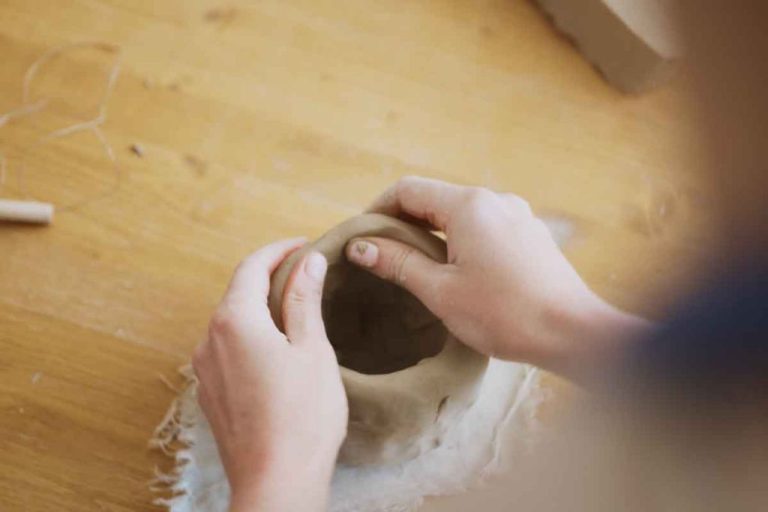How Do You Make Clay With Color?
Making your own colored clay at home is a fun and creative way to produce custom clay for arts and crafts projects. Clay is a moldable material made from natural minerals, clay powder, and water. The clay dries hard but remains flexible when heated, making it ideal for sculpting and molding into various shapes and sizes. Colored clay adds vibrant hues and visual appeal to handmade clay crafts and ceramics.
There are a few different methods for making homemade colored clay. The most common technique involves starting with a neutral clay base, like an air-dry white clay or polymer clay. Powdered tempera paints or other color pigments are then mixed into the base clay to achieve the desired colors and shades. The colored clay can be blended, swirled, or marbled to create colorful clay perfect for all kinds of clay crafts and pottery.
Gather Materials
Collect a few basic materials before you start making colored clay. The core ingredient is air-dry clay, sometimes called “modeling clay” or “play clay.” This is easy to mold and sets up hard once dry. Look for air-dry clay at craft stores or online.
The next key item is paint for adding color. Liquid tempera paint and acrylic paint both work well. You can also use powdered pigments. Opt for non-toxic paints without strong fumes.
To mix the clay and paint, have on hand some mixing tools like plastic knives, popsicle sticks, toothpicks, or silicone spatulas. Use clean containers for blending the paint into the clay, such as plastic cups, bowls, or zip top bags.
Make the Clay Base
When making colored clay, it’s important to start with the right amount of clay for your planned project. If working on a smaller item like jewelry or figurines, a few ounces or a pound of clay should be sufficient. For larger sculptures or pots, you may need several pounds of clay as your base material.
Before adding any color, take the time to properly knead and condition your clay. Kneading helps blend the clay compounds together evenly and removes any air bubbles that could cause cracks or defects once baked. It also makes the clay smoother and easier to work with when adding colorants and shaping your creation. Be sure to knead the clay adequately, for at least a few minutes, until it becomes soft, pliable, and elastic.
Starting with a smooth, elastic clay base is key for evenly distributing and blending in color for a professional, handmade look. Avoid adding colors or elements like glitter before properly kneading the clay first. The time spent prepping the clay will pay off later with stunning, vividly-colored polymer clay creations.
Add Color
Adding color to clay is one of the most exciting parts of the clay making process. Start by adding just small amounts of colorant to achieve the shade you want. It’s easy to add more color, but much harder to remove it. Liquid colors will usually produce a more vibrant, intense shade while powdered colors create a softer, pastel look.
To mix the color evenly throughout the clay base, knead and fold the clay over itself repeatedly. You may need to knead for several minutes to achieve an even distribution of color. Take a small piece of clay and roll it into a ball to test that the color is consistent all the way through. If not, continue kneading until the color is uniform.
Avoid overmixing colors or kneading too vigorously as this can cause the clay to become stiff. Gentle folding and pressing motions are best for blending in color. And be sure to wash hands or wear gloves when working with strongly pigmented colors to avoid staining skin.
Blend Colors
When blending colors into your clay base, you’ll want to mix thoroughly without overworking the clay. Here are some tips for blending:
- Start with a small amount of color and knead it into the clay a bit at a time
- Fold the clay over itself rather than continuously pinching or squishing
- Avoid mixing too vigorously or for too long, as this can blend the colors into an muddy hue
- Add color gradually until you achieve the desired shade
- If the color starts becoming uniform, stop mixing – you don’t want the color to become fully blended throughout
Overmixing can cause a few issues. First, it will dull the vibrancy of the colors. Too much blending will turn bright, saturated hues into something more muted. Second, overworking the clay can make it start to dry out, become brittle, or crack. You want to mix just enough to distribute the colors without homogenizing them completely.
Test out your color combinations on a small piece of clay first before mixing large batches. This way you can perfect the color blending before committing to a full project.
Store the Clay
Properly storing your homemade colored clay is important for keeping it workable and preventing it from drying out. Here are some tips:
Airtight containers: Store clay in airtight plastic bags or containers. This prevents air from reaching the clay and drying it out. Glass jars or plastic storage bins with tight lids work great.
Add moisture: If your clay starts to dry out, add a damp paper towel to the storage container to add moisture back. Re-knead the clay after adding moisture so it distributes evenly.
Keep cool: Store clay away from direct sunlight and heat. Warm temperatures will cause clay to harden. Store clay in a cabinet, pantry or basement where temperatures stay around 60-70°F.
Seal thoroughly: Make sure clay is sealed in an airtight container with no air gaps. Air exposure is the main cause of clay drying out. Wrap a plastic bag tightly around clay blocks before putting into a container.
Use quickly: Try to use homemade clay within 6 months. As time passes, clay will gradually dry out. For long term storage up to 1 year, add a moist paper towel and seal airtight.
Troubleshooting
When working with colored clay, you may run into some issues like the clay being too wet or drying out too quickly. Here are some tips for troubleshooting common problems with colored clay:
Fixing Clay That is Too Wet
If your colored clay is sticky or mushy, it likely has too much moisture content. There are a few ways to fix wet clay:
- Let it sit uncovered overnight to air dry.
- Knead in a bit of cornstarch, flour or baking soda to absorb excess moisture.
- Add a portion of dry clay to absorb the moisture.
- Bake the wet clay for 5-10 minutes to dry it out, then allow it to cool before handling.
Dealing with Clay Drying Out Too Quickly
On the other hand, clay can become dried out and crumbly if left uncovered for too long. To rehydrate dried clay:
- Knead in a few drops of water at a time until the clay is smooth and pliable.
- Wrap the clay tightly in plastic wrap or put it in an airtight container to help retain moisture.
- Consider adding a damp paper towel to the storage container to create a humid environment.
- If the clay is severely dried out, soak it in water briefly to rehydrate before kneading and using.
With some minor troubleshooting, you can get your colored clay back to the perfect consistency for any project.
Color Combinations
When mixing colored clay, it helps to have an understanding of color theory and how to combine colors harmoniously. Here are some ideas for pleasing color schemes to try with your homemade modeling clay:
Favorite Color Schemes
Analogous colors are groups of three colors that sit next to each other on the color wheel, like red, orange, and yellow. They create a vibrant look. Triadic color schemes use three colors equally spaced around the color wheel, like red, yellow, and blue. They form a very energetic, contrasting combo. Monochromatic palettes stick to shades of one single color. This creates a calm, cohesive look.
Complementary Colors
Complementary colors are opposite each other on the color wheel, like red and green or blue and orange. When placed next to each other, they create strong contrast. To make complementary colors less jarring, try separating them with a neutral color like white, gray or black.
Monochromatic Colors
Using varied shades, tints and tones of one single color can produce an elegant, soothing palette. Try light, medium and dark blue or soft pink and bold fuchsia for a monochromatic look. Adding white, black or gray creates more diversity within the mono color scheme.
Project Ideas
Colored clay opens up a world of DIY project possibilities. Here are some fun things you can make with your homemade colored clay:
Jewelry
Clay is a perfect material for making jewelry. Create beads, pendants, charms, and more. Use cookie cutters or silicone molds to make shaped beads. Lay flat clay pieces on top of textured materials like lace or leaves before baking to imprint designs. Stack and roll different colored clays to create multi-layered beads. The options are endless!
Magnets
Make magnets in any shape and size, featuring your favorite colors. Cut out clay shapes using cookie cutters and let the kids decorate. Or roll snake coils of clay, overlapping the colors. Refrigerator magnets make great gifts too.
Ornaments
Customize ornaments for any season or holiday. Make round ball ornaments and embed clay cut-out shapes into them before baking. Or roll flat clay sheets and cut into geometric shapes to hang on the tree. Create ornaments with your kids featuring their handprints!
Decorative Objects
The sky’s the limit for decorative pieces. Make customized photo frames, bookends, boxes, figurines, wall plaques, candle holders, coasters, and more. Use your own creativity or look online for inspiration. Colored clay allows you to make completely one-of-a-kind, personalized home decor items.
Expert Tips
We spoke with Susan, a professional clay artist with over 20 years of experience, to get her expert tips for working with colored clay.
“When mixing colors, start with a small amount until you get the color right. You can always make more, but you can’t take the color out once it’s mixed in,” Susan advised. “Have separate work areas for each color to avoid unintended mixing. And wait until colors are blended completely before adding more color, or you may end up with an uneven hue.”
Susan’s top tricks include:
- Rub a thin coat of olive oil on your hands and work surface when conditioning colored clay. This prevents staining.
- To marble clay, roll out two colors separately, then stack and twist them together.
- If clay becomes too sticky while working, let it rest for 10 minutes wrapped in plastic before continuing.
- Store unused colored clay in airtight plastic bags to prevent drying out.
“Take your time experimenting and don’t be afraid to make mistakes,” Susan encouraged. “Creating with colored clay is an art. The more you work with it, the more unique, beautiful projects you’ll be able to design.”




